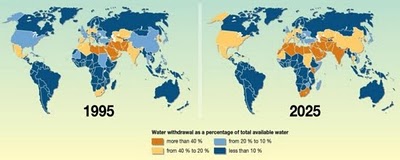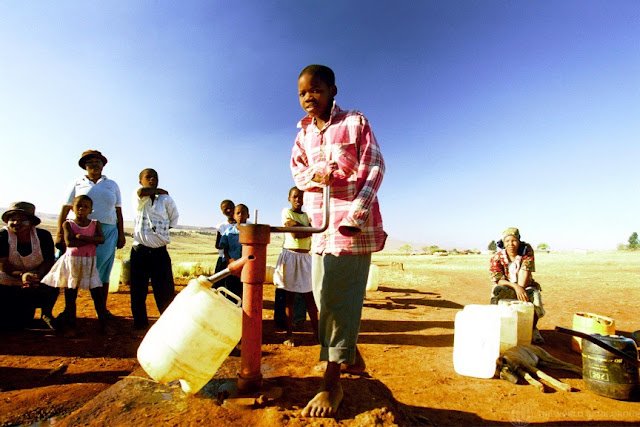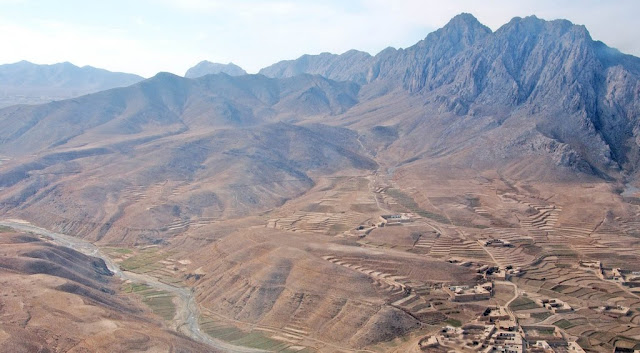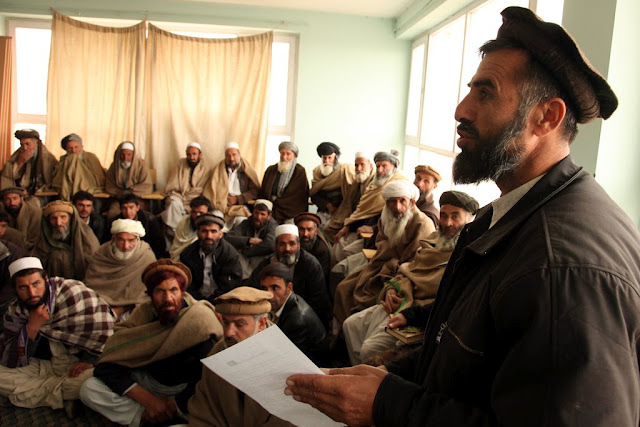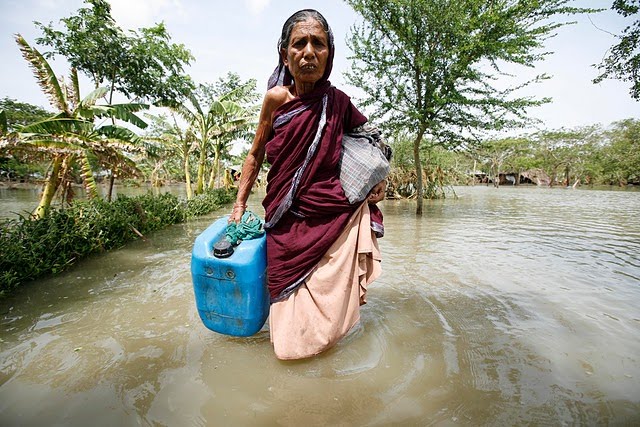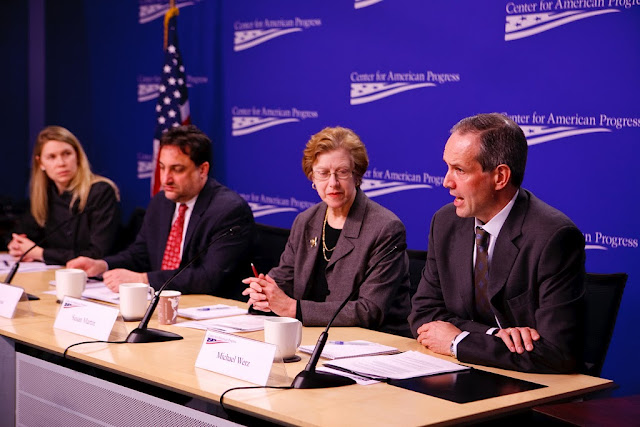-
City Living: World Health Day 2010 Focuses on Urban Health
›April 7, 2010 // By Julien KatchinoffCelebrating World Health Day, the World Health Organization, with its partners around the globe, today launched an initiative for healthly lives in urban settings, through the theme “1000 Cities, 1000 Lives.” “We are at a critical turning point in history where we can make a difference,” said Dr Ala Alwan, assistant director-general for noncommunicable diseases and mental health.
Since the first World Health Day 60 years ago, the world has seen a dramatic rural exodus. Today, more people live in urban areas than anywhere else. Providing healthy livelihoods for the urban poor is a challenge, as poverty-stricken urban centers face a number of health obstacles, from high child mortality rates, environmental pollution, and widespread disease, to a lack of access to basic water, sanitation, and health care.
“In general, urban populations are better off than their rural counterparts,” said WHO Director-General Margaret Chan. “They tend to have greater access to social and health services and their life expectancy is longer. But cities can also concentrate threats to health such as inadequate sanitation and refuse collection, pollution, road traffic accidents, outbreaks of infectious diseases and also unhealthy lifestyles.”
The 1000 Cities campaign hopes to encourage all cities to promote healthy activities during the week following World Health Day (4/7-4/11). Through a new website, the WHO is collecting profiles and pictures in an easy-to-navigate map. Notable activities include HIV/AIDS-awareness flashmobs, skateboarding and cycling competitions, car-free days, outdoor sports events, and dance performances, in cities as diverse as Mandalgobi, Mongolia; Bangalore, India; and Luanda, Angola.
The Wilson Center’s Environmental Change and Security Program and its Comparative Urban Studies Program have collaborated on urbanization events and publications that examine the strong and critical connections between healthy urban populations and environmental sustainability.
With proper attention paid to delivering population, health, and environmental services in our urban centers, it may be possible to leverage the benefits of higher urban densities—such as lower aid dispersion costs, communication access, infrastructure services, and fertile environments for ideas and productivity—to ensure urban sustainability for the future. -
Watch: Jennifer Dabbs Sciubba on Bringing Demography Into the Classroom
›April 7, 2010 // By Julien Katchinoff“You can’t just mention [population] in passing…If you’re going to talk about it, [students] will probably be interested in it, and you have to give it a really serious treatment,” cautioned Jennifer Sciubba, Mellon Environmental Fellow and professor at Rhodes College, during a panel discussion on science and policy in the classroom at the 2010 International Studies Association Conference.
Drawing on her experience as a practitioner of population studies, both within the Beltway and in the classroom, Sciubba shared techniques for bridging the gaps that exist between the study of political science and issues of population and environment. “I don’t think there’s that much of a difference between policy makers and students in some ways. They want to know the solutions, and they want you to break it down for them,” she said.
Bringing demography into the classroom should not start with population, recommended Sciubba. Rather, population and environment should be thought of as elements that shape and facilitate understanding of each topic covered in International Relations theory, from issues of conflict, war, and cooperation, to economics and development.
“It’s possible,” she concluded, “to put these things in any course–they’re part of the discipline. If we go back to some of the roots of international relations, this is how people thought of it to begin with and it’s very interesting to get back to that.”
Jennifer Sciubba is the author of a forthcoming book on demography and security, The Future Faces of War: Population and National Security, Praeger International Security Press, 2010
-
A Tough Nut to Crack: Agricultural Remediation Efforts in Afghanistan
›April 5, 2010 // By Julien Katchinoff“It was pretty much a normal day in Afghanistan on Monday.
Though only earning a glancing mention in The New York Times, it is heartening to see a response to the environmental and economic loss of Afghanistan’s once abundant wild pistachio forests. As a result of wide-spread environmental mismanagement and war, the past 30 years have seen a dramatic decline in the wild pistachio woodlands native to Northwestern Afghanistan.
“A couple of civilian casualties caused by insurgents. More investigations into corrupt former ministers. The opening of six new projects in Herat Province by the Italians and the Spaniards, which are the NATO countries in the lead in western Afghanistan. All right, not six, projects, but two or three, and the Spanish announced a pistachio tree-growing program to replace poppies. Pistachios, poppies… maybe pine nuts will be next.”
— At War: An Airborne Afghan Folk Tale, Alissa J. Rubin, New York Times, April 1, 2010
In a 2009 survey of Afghanistan’s environmental challenges, UNEP found that, while in 1970 “the Badghis and Takhar provinces of northern Afghanistan were covered with productive pistachio forests and earned substantial revenue from the sale of nuts,” few remain as the forests have since succumbed to mismanagement, war, and illegal logging.
In this video by the Post-Conflict and Disaster Management Branch of UNEP, scenes of dusty and denuded hillsides clearly show that rural Afghan farmers in search of sustainable livelihoods have few options remaining.
The project mentioned in the New York Times is a recent foray into remediation efforts by a Spanish Provincial Reconstruction Team (PRT) that targets communities previously involved in the production of illegal drugs. In conjunction with the Spanish Agency of Coordination and Development (AECID), the Spanish PRT is working in over 13 sites in Baghdis province–a region once covered in pistachio trees–to help farmers transition to legal crops and restore the traditional pistachio forests to their former prominence. AECID joins the Afghan Conservation Corps (ACC), USAID, NATO and additional partners in promoting remediation projects to reverse deforestation.
Unfortunately, these programs face daunting obstacles, as pistachio and other traditional Afghan cash crops –such as raisins, figs, almonds and other nuts– require substantial re-investments of time, money, and infrastructure development. Furthermore, convincing desperate rural farmers to transition to nearly untested alternative crops is difficult when they are currently counting the days to the spring opium harvest.
Recently, eradication efforts targeting small-scale farms have abated, and increased attention is being paid to facilitating shifts toward new products through free seeds, loans, technical assistance, and irrigation investments. If successful, these projects will grant rural Afghan communities the ability to sustainably and legally provide for their families, providing long-term employment and returns for a region lacking in both money and hope for the future.
Video Credit: UNEP Video, “UNEP observes massive deforestation in Afghanistan” . -
The Plight of Urban Refugees in Nairobi
›“The Traditional image of life in tented sprawling camps no longer tells the full refugee story.”– Hidden and Exposed: Urban Refugees in Nairobi, Kenya
Coinciding with the end of UN-HABITAT’s 5th World Urban Forum, a new report and associated video, Hidden and Exposed: Urban Refugees in Nairobi, Kenya, have been released by the Humanitarian Policy Group (HPG) at the Overseas Development Institute (ODI) and the International Rescue Committee (IRC).
Hidden and Exposed removes the cloak of migration stereotypes and provides an unfiltered look at urban migrants’ struggle for daily survival. Focusing on seven neighborhoods with high refugee concentrations in Nairobi, the authors — through qualitative interviews and secondary data — found a unique, challenging urban environment for thousands of refugees. Aid and development groups often overlook these urban refugees, instead favoring work with traditional established camps on the urban periphery.
The HPG found that Nairobi’s 46,000 registered refugees represent a diverse mix of ethnic groups and nationalities, all trying to secure economic independence and security. While much research has been devoted to the traditional concept of displaced migrants in centralized ex-urban camps, such as Dadaab in Eastern Kenya, urban dwellers are just as vulnerable to insecurity, poverty, and harassment. With nebulous legal rights, facing discrimination and protected by only fragile support systems, the refugee community in Nairobi finds itself in a precarious situation.
In light of the challenges, the research team at HPG offered three basic recommendations as initial steps:
1. Protection:
2. Livelihoods:- Address confusion over legal rights to prevent issues of police harassment and community violence.
- Target a subset of donor funds for training local police forces and government agencies.
- Establish partnerships between the UNHCR and the Kenyan government to improve the latter’s Refugee Status Determination System.
- Funnel humanitarian and development aid toward legal aid services while also using innovative strategies to increase dialogue between urban refugees and the surrounding Kenyan communities.
3. Service Delivery:- Carry out surveys to better understand the Nairobi urban economy, including the informal sector.
- Support the government of Kenya in their efforts to help urban refugees to become self-reliant.
- Recognize the transition of refugees from sequestered camps to urban areas and develop an effective response.
- Secure Kenyan government permission for the issuance of work permits for refugees.
Fleeing conflict and attracted by the possibility of better jobs, services, or security, thousands of refugees have sought new lives in Nairobi. Yet the reality for many urban migrants is an existence burdened with inadequate assistance, a precarious legal status, and economic and physical insecurity. Through the implementation of these recommendations, HPG hopes to draw attention to these hidden refugees, and offer them the hope of improved livelihoods and effective security.- Design aid models to address the unique challenges faced by urban refugees in Nairobi.
- Ensure coordinated and comprehensive services, in conjunction with the Kenyan government and international organizations, to address the needs of the urban refugees and the surrounding communities, with particular attention granted to refugee women and girls.
-
Tapping In: ‘Secretary Clinton on World Water Day’
›March 23, 2010 // By Julien Katchinoff “It’s not every day you find an issue where effective diplomacy and development will allow you to save millions of lives, feed the hungry, empower women, advance our national security interests, protect the environment, and demonstrate to billions of people that the United States cares. Water is that issue,” declared Secretary of State Hillary Clinton at a World Water Day event hosted by the National Geographic Society and Water Advocates.
“It’s not every day you find an issue where effective diplomacy and development will allow you to save millions of lives, feed the hungry, empower women, advance our national security interests, protect the environment, and demonstrate to billions of people that the United States cares. Water is that issue,” declared Secretary of State Hillary Clinton at a World Water Day event hosted by the National Geographic Society and Water Advocates.Alongside speeches by representatives from government and the non-profit sector, Secretary Clinton repeatedly emphasized America’s support for water issues. “As we face this challenge, one thing that will endure is the United States’ commitment to water issues,” she asserted. “We’re in this for the long haul.” Beyond simply highlighting the importance of the issue, Secretary Clinton also affirmed commitment to new programmatic, cross-cutting initiatives that will target water as a keystone for development and peace.
ECSP Director Geoff Dabelko, who attended the event, noted that Secretary Clinton’s speech ran counter to the much publicized notion that water scarcity is an unavoidable catalyst for conflict.
She came down squarely on the side of inclusion by identifying water as both a ‘human security’ and ‘national security’ issue. At the same time, she did not fall prey to the common pitfall of arm-waving about water wars. She flagged conflict and stability concerns, but also raised solutions through meeting needs associated with water and development. She went out of her way to emphasize water’s potential for peace and confidence-building, reflecting a commitment to capturing opportunities rather than merely identifying threats.
Secretary Clinton highlighted five crucial areas that comprise the United States’ whole-of-government approach to water issues:
1. Building capacity:
Through efforts with international partners, the United States hopes to strengthen the abilities of water-stressed nations to manage vital water resources. Agencies such as the Millennium Challenge Corporation and USAID are implementing initiatives that will enhance national ministries and encourage regional management cooperatives.2. Elevating diplomatic efforts:
A lack of coordination between the numerous UN agencies, governments, and multilateral funding organizations hinders global water progress. By bringing this work together, the United States can act as a leader, demonstrating a positive diplomatic precedent for fragile and water-stressed nations.3. Mobilizing financial support:
Relatively small grants have achieved large impacts. Work by the United States to strengthen capital markets in the water sector shows that it is possible to earn large returns on water investments. Successful examples range from educational and awareness-building programs, to desalinization and wastewater treatment plants.4. Harnessing the power of science and technology:
Although there is no silver technological bullet to solve the global water crisis, simple solutions, such as ceramic filters and chlorine disinfection systems, do help. Additionally, sharing government-accumulated technological knowledge can have significant impacts, as demonstrated in a recent NASA-USAID project establishing an Earth-observation monitoring and visualization system in the Himalayas.5. Broadening the scope of global partnerships:
By encouraging partnerships and elevating water in its global partnership initiatives with NGOs, non-profits, and the private sector—all of which are increasingly engaged in water issues—the Department of State hopes to maximize the effectiveness of its efforts.The holistic approach advocated by Secretary Clinton reflects a distinct evolution of American diplomacy within this area, which is strongly supported by the water community. “The policy directions outlined in the speech, the five streams, represent a victory for those in and outside of government who have argued for a broad, rather than narrow, view of water’s dimensions,” said Dabelko. “The diversified strategy focuses on long-term and sustainable interventions that respond to immediate needs in ways most likely to make a lasting difference.”

In her concluding remarks, Secretary Clinton sounded a positive note, noting that for all of the press and attention devoted to the dangers of the global water crisis and the possible dark and violent future, dire predictions may be avoided through a smart, coordinated approach. “I’m convinced that if we empower communities and countries to meet their own challenges, expand our diplomatic efforts, make sound investments, foster innovation, and build effective partnerships, we can make real progress together, and seize this historic opportunity.”
Photo Credits: State Department Official Portrait; UNEP.
-
‘A Question of Quality: ’ World Water Day 2010
›March 22, 2010 // By Julien KatchinoffWorld Water Day 2010, dedicated to the issue of water quality, points to a challenge that is often omitted from the scarcity debate. Today, through a variety of global events, publications, and speeches, a large coalition of organizations, companies, and institutions will underline the importance of healthy ecosystems and water quality necessary for human well-being.
A participating partner in this initiative, the National Geographic Society, has made its special issue on water, Water: Our Thirsty World, available for free online. After registration, readers may find the following stories interesting:
“Water is Life” – Barbara Kingsolver
“The Big Melt” – Brook Larmer
“Sacred Waters” – John Stanmeyer
“The Burden of Thirst” – Tina Rosenberg
“Silent Streams” – Douglas H. Chadwick
“California’s Pipe Dreams” – Joel K. Bourne, Jr.
“Parting the Waters” – Don Belt
“The Last Drop” – Elizabeth Royte
Photo Credits: “Rural water pump near Ulundi, South Africa” Photo: Flickr User Trevor Samson, World Bank Photo Collection -
Copper in Afghanistan: Chinese Investment at Aynak
›Will new investments by the Metallurgical Corporation of China (MCC) in the Aynak copper mine break Afghanistan out of its poverty trap? Will future revenues from the subsoil assets in Logar Province bring peace and stability to the ongoing conflict?
The U.S. Institute of Peace brought together expert panelists to discuss the pitfalls and possibilities related to the Aynak contract. Discussed were current uncertainties in investment plans, future risks related to mine operations, how the various stakeholders of the Aynak project can be more engaged in the process, as well as the planned reinvestment of economic benefits within the broader economy.
Alone, the Aynak Copper Mine’s multi-billion dollar reserves will not bring about security, but its success can be a gateway to future development. According to Lorenzo Delesgues, co-director of Integrity Watch Afghanistan, however, there is also a chance that this conflict-ridden region will find the mines a catalyst for more disputes. According to Delesgues, the potential negative impacts on the surrounding communities and the environment “can be exacerbating factors that might create even more insecurity than what you already have in that area.”Delesgues suggested that certain programmatic alterations needed to be considered by the MCC and the Afghan government to leverage local sustainable economic development beyond Aynak. For Delesgues, local communities need better information about mining’s environmental and employment impacts to improve their decision-making abilities, as many common social and environmental protections are lacking from the current MCC mining plans and activities. An environmental impact assessment, for example, has not yet been carried out, leading to concerns that on-going exploration activities may harm the local environment and downstream populations. To prevent future disputes, Integrity Watch Afghanistan recommends strengthening project monitoring processes and greater public communication and consultation with key stakeholders.
Gary McMahon, senior mining specialist at the World Bank, believes that Afghanistan is in a good position to benefit from the Aynak copper mines. Local employment generation and the MCC’s stated commitment to provide educational, health, and housing services to employees all offer promise for development. There are also contractual obligations for a power plant that will supplement a portion of Kabul’s current demand and the construction of a railway system through Afghanistan, which will extend from China to Tajikistan, and strengthen existing Afghan trade networks.
While the royalty rates established by the Afghan government in the Aynak contract on future mining revenue streams are unprecedented in the mining sector, McMahon fears that the revenue will solely follow international aid flows. “If all that happens is that fiscal revenues [from Aynak] replace foreign aid, the impacts are going to be way less,” says McMahon.
McMahon suggests that, moving forward, the Ministry of Mines and the National Environmental Agency’s capacities for monitoring and evaluation must be improved and strengthened. There also needs to be assurance that the local population gets a “fair share” of jobs and other opportunities, along with continuous consultation of the impact the mines are having on their social and environmental conditions.
In his concluding statements, Ishaq Nadiri, professor of economics at New York University and former senior economic advisor to Hamid Karzai, cautioned the audience about the weight that economics plays in the overall outcome of the Aynak Copper Mine. According to Nadiri, the objective in establishing the Aynak contract was to maximize national benefits. Nadiri offered hope that “the lack of security…[which] emanates from the highly chronic poverty of the country,” could find promising solutions in the wealth of Aynak.
Drafted by Michelle Neukirchen, edited by Julien Katchinoff.
Photo Credits: “River and Mountains of Logar,” courtesy of flickr user AfghanistanMatters and “Logar Province Shura,” courtesy of flickr user IsafMedia. -
A Forecast of Push and Pull: Climate Change and Global Migration
›March 10, 2010 // By Julien Katchinoff
“As we …talk about the interconnections between climate change and migration we need to look at the interconnections in a way that understands what’s positive about the processes of migration and what’s problematic,” said Susan Martin, Herzberg Professor of International Migration at Georgetown University, during a recent event on climate and migration at the Center for American Progress.
Susan Martin joined Cynthia Brady, senior conflict advisor for the Office of Conflict Management and Mitigation at USAID and David Waskow, director of the Climate Change Program at Oxfam America, to identify the catalysts for future population flows, offer pragmatic policy solutions, and discuss work to be done on the ground.
While reminding the audience that climate-induced migration will tend to follow already existing patterns, Susan Martin broadly outlined four major intersections between migration and climate change impacts:
“Slow” Migration Pressures:- Drought or desertification resulting in a loss or depreciation of livelihoods.
Result: Push working family members to migrate to domestic or international urban centers. - Rising sea levels damaging fishing and agriculture opportunities.
Result: Migration to inland regions to reduce future risk.
“Rapid” Migration Pressures:- Intensification of natural disasters and damage to infrastructure.
Result: The coping costs increase to the point where they push large numbers of people to leave their homes. Most individuals migrate internally. Of the four intersections, this is currently the most common. - Threats to the availability of food, water, and other natural resources.
Result: Low or high intensity conflict, leading to migrations. The short timeframes and potentially large numbers of migrants involved make this driver the most problematic. Differing degrees of internal political stability are factors that can interfere for better or worse.
Yet these relationships are not without controversy. “Environmentalists have tended to see the issue of migration as a way of getting attention to mitigation and have often talked about migration in very alarmist terms,” Martin said. “Migration experts, on the other hand, have been very skeptical about the interconnection.” Instead, they have argued that other push and pull factors outside of climate are much more significant to the migration calculation.

Operating from the perspective that migration itself is an adaptation failure, David Waskow outlined several strategies that Oxfam deploys to help communities copewith uncertain futures:
- Building climate resilience and developing adaptation strategies: Proactive approaches are essential, as agencies and communities can address future threats with disaster planning and creating early-warning systems.
- Managing risk: The establishment of micro-insurance projects can cushion vulnerable populations against unexpected economic shocks.
- Resettling communities: The movement of rural populations to urban areas could result in tensions over land use and strains on urban governance and carrying capacities. As a result, this approach is left as a last recourse.
Brady, though in agreement with Waskow concerning climate change’s threat to livelihoods and its role as a catalyst for conflict, suggested that there may be positive opportunities for managing climate risks. “The environment can and does provide an essential and effective platform for dialogue, communication, and confidence-building around shared interests,” Brady said. “It may be that certain conflicts actually lend themselves to the use of climate-related collaboration as a mechanism to resolve conflict or reduce tension between parties,” she said.
Climate-related projects at the community-level, from adaptive early-warning systems to mitigating carbon storage schemes, hold the possibility to bring groups together in cooperative projects, build confidence, and defuse existing tensions. Transparent and participatory management of new investments may also increase trust in local and national governments with whom trust was previously lacking. While forestalling crises in the future, adaptation projects also hold the potential to unlock opportunities for peacebuilding and conflict resolution today.
Photo Credits: Photo 1 courtesy Oxfam America. Photo 2 courtesy Center for American Progress. - Drought or desertification resulting in a loss or depreciation of livelihoods.
Showing posts by Julien Katchinoff.



 “It’s not every day you find an issue where effective diplomacy and development will allow you to save millions of lives, feed the hungry, empower women, advance our national security interests, protect the environment, and demonstrate to billions of people that the United States cares. Water is that issue,” declared Secretary of State Hillary Clinton at a
“It’s not every day you find an issue where effective diplomacy and development will allow you to save millions of lives, feed the hungry, empower women, advance our national security interests, protect the environment, and demonstrate to billions of people that the United States cares. Water is that issue,” declared Secretary of State Hillary Clinton at a 